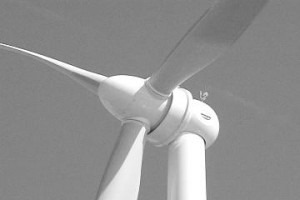Environmental agency puts turbines to good use

Wherever you go on the Providence waterfront these days, they are impossible to miss: Three massive wind turbines that have changed the landscape of the Providence River.
So who, you may wonder, put them up, and why? And why are they not spinning yet?
Thomas Uva oversees the turbine project for the Narragansett Bay Commission, which handles the wastewater for 10 communities and 70 percent of all households that have sewers in Rhode Island. The commission handles 30 billion gallons of sewage annually, spending $4 million per year on electricity.
Uva: We depend on electricity. Wastewater treatment plants are the largest users in the country.
Hummel: Even a small rate increase that might cost me $20 in my house, translates into hundreds of thousands of dollars for you.
Uva: Absolutely, absolutely and that translates into the 10 cities and towns we send bills out to, so anything we can do to stabilize our electric rates helps our ratepayers.
So the commission began exploring wind energy six years ago. It’s taken that long to go through feasibility studies, zoning approval and to figure out the economics.
Uva: We did extensive studies on wind energy. We put up meteorological towers so we could measure wind speed throughout a two-year period almost. So we had plenty of wind data, so we knew this was a potential good site. Not a site an expensive developer might go in to build in, but because we could use the energy here. It was very cost-effective and a good opportunity for us.
Hummel: Did your gut tell you that you thought the wind was good or were you surprised when the results came back?
Uva: No, I wasn’t surprised. It’s windy here every day. The way the wind comes up Narragansett Bay it’s almost like a funnel and it blows the wind right up the bay right over our facility.
And that’s one of the big differences between this project and a failed proposal in North Kingstown, last year, that ultimately collapsed under the weight of public controversy. The turbines are located in an industrial area, but the commission reached out to those living miles away in residential neighborhoods as well.
Uva: And we sent letters out to 300 of our neighbors and we had two public meetings. In addition to the letter, we sent a survey out asking if they favored wind power and overwhelmingly the surveys that were returned to us were in favor of seeing wind turbines go up in the area.
The project will cost $12 million and is being financed through revenue bonds. The commission expects to have it paid off in 12 years and the life expectancy of the turbines is 20 to 25 years. No federal money is involved and because some of the parts were manufactured overseas the commission could not use stimulus money.
Uva: There’s one turbine manufacturer in America that makes these size turbines and that was General Electric. They wouldn’t even talk to us. They want to do large wind farms. They don’t want to do small projects like this.
Hummel: So three turbines to them was not worth their time?
Uva: They wouldn’t even talk to us.
This project is also different from the controversial turbine the town of Portsmouth put up several years ago — with the purpose of selling all of the electricity it produced back to National Grid. The Narragansett Bay Commission estimates it will be able to supply 40 percent of the power it needs power from the three turbines — and sell back any excess to the grid during off-peak use times.
The 363-foot turbines arrived in pieces by boat and by truck in January and the commission put together this time-lapse video together when they were assembled over the course of five days in February. They are located in a big triangle on the commission’s property at Field’s Point.
Hummel: Tell me why it takes so long, from February to June or July, when you get them online.
Uva: It’s similar to building a house and when you build a house you pour your foundation and build the walls and you put the roof in and button up the house. Then you have to go inside and put up your sheetrock, put in your insulation, put in your wiring and electricity. And that’s where we stand right now.
The commission is also building a huge central link that will take in the electricity produced from all three turbines and distribute it.
Uva: Jim, if you can’t put up wind turbines in this industrial area, Field’s Point, you can’t put them up anywhere in Rhode Island. It’s not going to happen. I view these as three beautiful flowers that have blossomed in piles of coal, salt and scrap metal and I can’t wait to see them start spinning and generating power for our ratepayers.
Uva expects the three to go online sometime this summer.
The Hummel Report is a 501 3C non-profit organization. If you have a story idea or want make a donation to the Hummel Report, go to www.hummelreport.com. Or mail Jim directly at jim@hummelreport.com.
News
